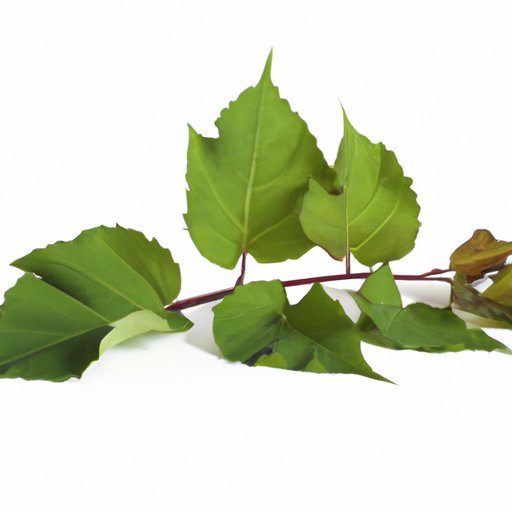
I. Introduction
Poison ivy is a pesky plant that can cause an itchy and uncomfortable rash. It’s important to know how to get rid of poison ivy to prevent it from spreading. In this article, we’ll go over natural remedies, over-the-counter options, medical treatment, and preventative measures, as well as some simple home remedies and personal experiences.
II. Natural Remedies
Natural remedies can be very effective in treating poison ivy. Here are some of the best ones:
Baking soda paste
Mix three parts baking soda and one part water to make a paste. Apply the paste to the affected area and let it dry. Wash it off with cool water. You can repeat this treatment two to three times per day.
Apple cider vinegar
Soak a cotton ball in apple cider vinegar and apply it to the affected area. This can help dry out the rash. You can repeat this treatment two to three times per day.
Oatmeal baths
Add a cup of colloidal oatmeal (finely ground oatmeal) to a lukewarm bath. Soak in the bath for 15 to 20 minutes. This can help soothe the itchiness associated with poison ivy.
Essential oils, such as tea tree oil
Mix a few drops of tea tree oil with a carrier oil like coconut oil, and apply this mixture to the affected area. Tea tree oil can help soothe the itch and dry out the rash.
III. Over-the-counter remedies
Over-the-counter remedies can be a convenient and effective option for treating poison ivy. Here are some of the most popular ones:
Hydrocortisone cream
Hydrocortisone cream can help reduce inflammation and alleviate itching. Apply it directly to the affected area up to four times per day.
Calamine lotion
Calamine lotion can help dry out the rash and relieve itching. Apply it to the affected area up to four times per day.
Anti-itch sprays
Anti-itch sprays contain ingredients like benzocaine or pramoxine that can help reduce itching. Spray it directly onto the affected area up to four times per day.
It is important to note that these remedies are only effective for mildly affected areas of skin. A severe rash should be treated by a medical professional.
IV. Medical Treatment
If the rash is severe, medical treatment may be necessary. Here are some of the prescription creams and medications that can help:
Topical corticosteroids
These creams can help reduce inflammation and alleviate severe itching.
Oral corticosteroids
If the rash is widespread, oral corticosteroids may be prescribed to reduce inflammation throughout the body.
Antihistamines
Antihistamines can help relieve itching and reduce swelling.
If you develop a fever, notice pus or drainage from the rash, or experience severe swelling or difficulty breathing, seek medical help immediately.
V. Preventative Measures
The best way to deal with poison ivy is to avoid getting it in the first place. Here are some tips:
Identify poison ivy
Learn to identify poison ivy and avoid it when possible. Remember that poison ivy can grow as a vine or a shrub.
Cover up when you’re in heavily wooded areas
Wear long pants, long sleeves, and shoes that cover your feet when you’re spending time in the woods.
Properly wash after potential exposure
Use soap and cool water to wash your skin if you think you’ve come into contact with poison ivy. Dirty clothes can also spread the rash, so wash them separately in hot water.
VI. Home Remedies
If you’re looking for simple home remedies to treat poison ivy, here are some options:
Aspirin paste
Crush up aspirin tablets and add a little water to make a paste. Apply the paste to the affected area and let it dry. This can help reduce inflammation and alleviate itching.
Witch hazel
Apply witch hazel directly to the affected area using a cotton ball. This can help reduce inflammation and soothe the skin.
Lemon juice or banana peels
Rub fresh lemon juice onto the affected area, or apply the inside of a banana peel to the rash. Both can help reduce itching and inflammation.
VII. Personal Experiences
Many people have dealt with poison ivy and have their own unique remedies that worked for them. Some people recommended products like Tecnu that help break down the oils from the plant. Others found relief by soaking in a bath with Epsom salt or using a hair dryer to blow cool air onto the rash.
Ultimately, everyone’s experience with poison ivy is unique, and what works for one person may not work for another. So, it’s important to try out different remedies and find what works best for you.
VIII. Conclusion
Poison ivy can be an annoying and uncomfortable rash to deal with, but there are plenty of remedies available. Natural remedies like baking soda paste, apple cider vinegar, oatmeal baths, and essential oils, as well as over-the-counter remedies like hydrocortisone cream and calamine lotion, can be effective for mild cases. For severe rashes, such as those involving pus or drainage, medical treatment is necessary. Preventative measures, such as covering up when you’re in wooded areas, can help keep you safe. Remember to experiment with home remedies, and seek professional help if needed.





